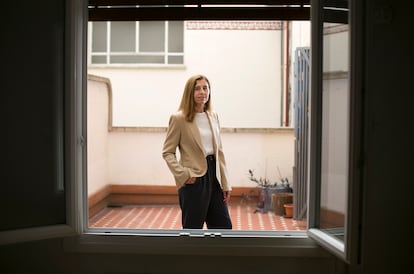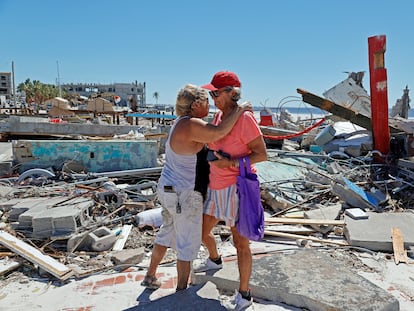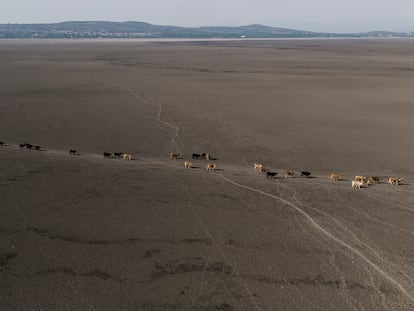Ana Barreira, lawyer: ‘We need judges who are specialized in the environment like we have for gender or minors’
The specialist in climate litigation analyzes the rise in environmental cases: ‘Any tool that tackles global warming is useful.’ These types of lawsuits are on the rise, particularly in the United States


Around the world, climate litigation is on the rise. Activists are using the courts to try to get governments to be more ambitious in the fight against climate change, to name and shame the most polluting companies, or to stop fossil fuel projects that further add to the climate crisis. The total number of cases worldwide has increased from 884 in 2017 to 2,180 in 2022, according to the latest report on climate litigation put together by the United Nations Environment Programme. The United States heads the list of nations with the most cases on the books, but over the years, these lawsuits have spread to other countries. And they have been brought before international courts such as the European Court of Human Rights (ECHR), where there are several open cases, including the one brought by six young people from Portugal who are suing 32 European countries. Ana Barreira is a lawyer and the founding director of the International Institute of Law and Environment (IIDMA), an organization created in 1997 that uses the law to promote environmental protection.
Question. What types of climate litigation already exist?
Answer. There are many categories. The best known, and those that attract the most media attention, are those that are directed against states and are brought by individuals demanding more ambitious action on the climate from their governments. But there is also litigation against companies. In Europe, some of these cases have already been brought before the courts, but where they have occurred the most is in the United States. For example, a case filed against the construction of a coal-fired thermal power plant or a combined cycle power plant can also be considered climate litigation because they emit greenhouse gases. In Spain we no longer find cases concerning coal-fired plants, because the industry is dying out, but in many other countries in the world they continue to be built. Others may be lawsuits that have to do with not applying the environmental impact assessment on a project that may generate more emissions, as happened in the extension of one of the runways at Heathrow airport. In other words, there are multiple kinds of cases and there are multiple kinds of arguments that can be made.
Q. Does environmental and climate activism have a long history in the courts?
A. The first recorded climate litigation took place in the 1990s and was a case in Australia against the construction of a coal-fired power plant. But then more and more cases have continued to be brought as time has gone by and as legislation to combat climate change has been enacted, especially after the United Nations Framework Convention on Climate Change was signed in 1992. If we look at the statistics, the country that has the most climate litigation is in the United States. This is related, on the one hand, to the fact that very little has actually been done in the United States to combat climate change. And on the other hand, it is because it has a very different judicial system where precedents, which are the primary source of law, must be established. This is in comparison to civil law systems, such as those of many countries in the European Union and Latin America, where the written law is the primary source.
Q. Do you think litigation has been a useful tool so far?
A. I believe that all tools to address climate change are useful. Until now there have been cases that have served to move the struggle forward, although others have not been useful. There are cases that have set a precedent or that have attracted a lot of attention, such as the famous Urgenda case in the Netherlands, which was based on arguments more or less similar to those of the Juliana case in the U.S. But there have also been very interesting earlier lawsuits that the media did not pay attention to. Now the argument of protecting future generations is widely used, but in 1994 there was a groundbreaking case in the Philippines that used this reasoning against plans that involved deforestation. In that case, the concept that the Brundtland commission defended — meeting the needs of the present without compromising the needs of future generations — was used for the first time. It was a case brought by a number of children in the Philippines. Perhaps if as much attention had been paid to that case as there was to the Urgenda case, it would have had a much higher social impact and in more countries.
Q. Do you think that judges are now more sensitive to climate cases that defend the rights of future generations?
A. Talking about judges in general is very complicated, because it depends on the jurisdictions, judicial traditions, and on the training the judiciary receives in each country. There are countries in which there are courts that specialize in environmental issues. But judges are also people, and there is a greater awareness in society today than 10 or 20 years ago. Now, when analyzing a case, it is viewed differently. This has had an influence, because, although the law must be applied, there is a certain level of subjectivity. That is why I believe that there is greater receptivity, and this has been transferred to the judges’ decisions.
Q. And have you noticed this change at your organization?
A. In our work in Spain we have noticed improvements, but they have been very limited and only in certain areas. It also depends on the case you bring before the courts, because there are rules that are very simple to understand but there are also others that are very technically complex, and at times I don’t think the judges understand the arguments very well. There are exceptions, obviously, but the problem is that their training is not good enough. Judges have not been trained in these matters. Just as there is a prosecutor’s office that specializes in environmental cases and courts that deal with other, specific matters, we believe that special chambers and judges should be created for environmental cases, just as there are different courts for matters of gender or minors.
Q. On September 27, the European Court of Human Rights will hold a hearing in the case of the six Portuguese youths who have accused 32 countries of inaction on climate change. How significant is it that the case has reached the court?
A. The lawsuit was filed in 2020, before the European Union and many other states reviewed their climate commitments, and so we are in a very different situation now. I don’t know what’s going to happen, but I think it’s important. The very fact that it has reached the court has received media coverage, and that has raised its profile. This is part of what is called strategic litigation which is widely used in the Anglo-Saxon system. Sometimes, people file a lawsuit knowing in advance that they are not going to win, but they do it to draw attention to an issue that needs to be urgently addressed.
Q. Is the litigation more important than the judgement, then?
A. I don’t have a crystal ball, so I don’t know what the court will decide. But if the court does not rule in favor of the litigants, the whole process will drive changes in climate legislation anyway.
Q. It is striking that this case has reached the ECHR when the right to the environment is not included in the Convention on Human Rights.
A. The European Convention on Human Rights was signed in the 1950s, when society was not the same as it is now. The environment was not something that people were concerned about. Rather, this has developed over time. The convention includes what are called first and second generation human rights, but third generation rights, which are quite loose in their definition, are not included. As a consequence of gradual environmental degradation and its impact on other rights, recognition of the right to a healthy environment began to be introduced into many national constitutions from the 1970s onward. It is even included in other regional treaties for the protection of human rights. A reform has not been carried out in Europe yet, but I believe that it will certainly happen, especially as a consequence of the UN General Assembly’s recognition of the right to a healthy environment.
Q. In Spain, the first climate litigation against the state was rejected by the Supreme Court. Do you think there could be a successful lawsuit that obliges the country to present more ambitious plans to cut emissions?
A. I don’t think it’s possible right now. Furthermore, the European Union, which largely sets climate policy for Spain, is going to increase its commitments. I have seen all the [climate] developments in Europe and I think that the EU is very ambitious. It has always been a leader in the fight against climate change. In fact, in the negotiations of the United Nations Framework Convention on Climate Change, it was the EU that tabled setting emissions reduction targets, but no other countries wanted to. Many things are being done in Europe, such as changes in legislation, [increased use of] renewables, construction, and so on. We pay a lot of attention to the macro, but not to the micro and all the transformations that are being generated. I have spent my entire professional life focused on these issues, and I consider that for 20 years hardly anything happened, everything was very slow, but since the signing of the Paris Agreement in 2015, all the changes that have been made are incredible. Obviously, much more progress has to be made, I don’t deny it.
Q. Going down to the micro: in Spain, could there be a lawsuit against a mayor for removing bike lanes, as is happening after the municipal elections in some town councils?
A. I think it could happen because it means [the town is] adopting measures to hinder sustainable mobility, which is a very important element to tackle climate change, because cities contribute a lot to global warming through their emissions.
Q. Even the bike lanes are politicized, are they not?
A. I’ll give you an example. Bike lanes are used in a lot of the countries around us, as well as in China and many other places. In addition to the environmental advantages, there are health benefits for a population that gets around by bike. And that can even have a positive impact on health spending, due to the lower incidence of certain diseases. A lot of the time we do not see the issues systemically and we forget the interrelationships that exist.
Sign up for our weekly newsletter to get more English-language news coverage from EL PAÍS USA Edition
Tu suscripción se está usando en otro dispositivo
¿Quieres añadir otro usuario a tu suscripción?
Si continúas leyendo en este dispositivo, no se podrá leer en el otro.
FlechaTu suscripción se está usando en otro dispositivo y solo puedes acceder a EL PAÍS desde un dispositivo a la vez.
Si quieres compartir tu cuenta, cambia tu suscripción a la modalidad Premium, así podrás añadir otro usuario. Cada uno accederá con su propia cuenta de email, lo que os permitirá personalizar vuestra experiencia en EL PAÍS.
¿Tienes una suscripción de empresa? Accede aquí para contratar más cuentas.
En el caso de no saber quién está usando tu cuenta, te recomendamos cambiar tu contraseña aquí.
Si decides continuar compartiendo tu cuenta, este mensaje se mostrará en tu dispositivo y en el de la otra persona que está usando tu cuenta de forma indefinida, afectando a tu experiencia de lectura. Puedes consultar aquí los términos y condiciones de la suscripción digital.
More information
Últimas noticias
Most viewed
- Sinaloa Cartel war is taking its toll on Los Chapitos
- Oona Chaplin: ‘I told James Cameron that I was living in a treehouse and starting a permaculture project with a friend’
- Reinhard Genzel, Nobel laureate in physics: ‘One-minute videos will never give you the truth’
- Why the price of coffee has skyrocketed: from Brazilian plantations to specialty coffee houses
- Silver prices are going crazy: This is what’s fueling the rally










































